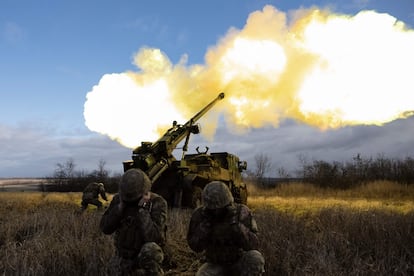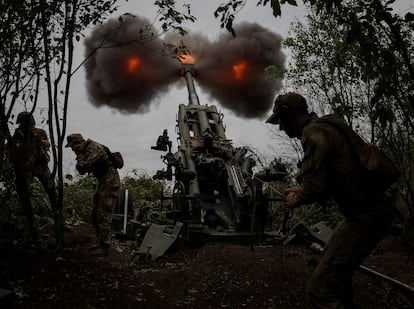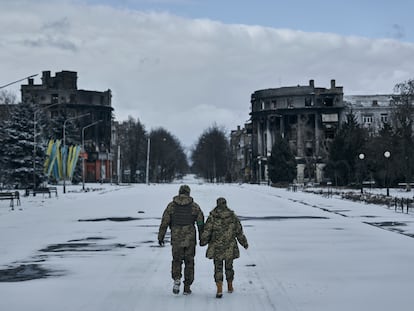155mm howitzers: The NATO weapon proving crucial to Ukraine’s defense
Artillery is one of the most decisive weapons Kyiv has to counter the Russian invasion but stocks of ammunition are running desperately low ahead of expected spring offensives

In a war where technical superiority is proving as important as tactical flexibility, Ukraine possesses a weapon that outstrips anything Moscow has in its arsenal: NATO medium- and long-range 155mm artillery. Without these guns, it is quite possible that Ukraine would have faced defeat. Such is the importance of these artillery pieces that Ukrainian Defense Minister Oleksii Reznikov said during a press conference on February 5 that his greatest achievement in his role has been guaranteeing supply at the outset of the invasion. The problem is that production of these weapons and ammunition in North America and Europe is lagging behind Kyiv’s necessities on the front lines.
NATO General Secretary Jens Stoltenberg acknowledged the issue, which analysts have been warning about for some time, a few days ago: the Ukrainian military urgently requires artillery munition and allied stocks are almost exhausted. “The current rate of Ukraine’s ammunition expenditure is many times higher than our current rate of production. This puts our defense industries under strain,” Stoltenberg said last Tuesday in Brussels. The NATO chief added the waiting time for the supply of “large-caliber ammunition has increased from 12 to 28 months,” and that “orders placed today would only be delivered two-and-a-half years later.”
On Saturday, European Commission President Ursula von der Leyen picked up the gauntlet during a speech at the Munich Security Conference by announcing a Europe-wide initiative that through a planned joint procurement scheme would facilitate the expansion of industrial production capacity.
Each of the 155mm guns at the disposal of the armed forces of Ukraine is protected as if the outcome of the war depended on it: artillery batteries quickly change their location to avoid being pinpointed by the enemy. These weapons were fundamental to much of Ukraine’s battlefield success last year, such as the recapture of the province of Kharkiv and the liberation of Kherson. Artillery barrages allow infantry to advance, but the 155mm guns are also proving vital to defense due to their precision in hitting Russian logistics and supply lines, severing support for combat troops on the front.

Ukrainian civilian and military authorities regularly cite a shortage of ammunition. Some 60% of Kyiv’s howitzer arsenal are old Soviet models using 122mm and 152mm caliber shells, which are no longer produced on a large scale in Ukraine or in Eastern Europe. Moreover, many of them are in poor condition, presenting a danger to the units that operate them. The remaining artillery pieces, according to a December count made by journalist and military analyst Volodymyr Dacenko, are 155mm caliber guns, homogenized in NATO countries. In total, Kyiv has around 350 of these and although Moscow has considerably more artillery – around three times as much by some estimates – the NATO weapons redress the balance as they are far more effective in terms of precision.
“With more long-range artillery, we would push the Russians back in Vuhledar,” an officer with the elite 68th Jager Infantry Brigade told EL PAÍS last Tuesday. Grey Zone, a Russian news channel on the Telegram social media platform, reported on February 13 that Ukrainian artillery superiority was one of the reasons that the Russian 155th Naval Infantry Brigade was almost entirely wiped out when it recently attempted to retake Vuhledar.
But Ukraine is short of guns and ammunition, as soldiers of the 65th Mechanized Infantry Brigade fighting on the Zaporizhzhia front told this newspaper on February 5. The French Caesar self-propelled howitzers and the American M777s used by the unit had been forced to considerably reduce their fire, prioritizing only the safest targets: convoys that informants in the occupied zones alert them to and which follow routes already tracked for firing coordinates. The 65th Brigade also confirmed that several units on this front have been redeployed to the defense of Bakhmut.

Jack Watling, an analyst at the British RUSI defense research institute RUSI, provided a comparative piece of data in recent analysis for NPR radio: in just eight days, Ukraine fires the equivalent of the total number of 155mm shells stockpiled by the United Kingdom. The United States, as reported by The New York Times last month, has already supplied one million 155mm shells, half of which were recalled from supplies Washington had ceded to Israel and South Korea. On February 15, Watling warned that NATO’s stockpile might last for “a few more months.”
While the US is planning to increase productions of 155mm shells fivefold over the next year and a half, as reported by CNN, Olha Husieva, an expert at the Institute for Security Policy at Kiel University, told EL PAÍS in a recent interview that the root of the problem is that NATO was not prepared to react to a large-scale invasion like Russia’s attack on Ukraine.
Ukraine’s main artillery support from the US M777 howitzers and the French Caesar self-propelled guns. Kyiv has around 150 of the former and 40 of the latter, supplied by France and Denmark, according to Ukrainian defense analysts. The M777 has a range of almost 20 miles when firing guided missiles and around 15 with standard munition. The Caesars are favored by Ukrainian artillery batteries as they have a range of up to 25 miles, making them harder to detect and intercept.
The most modern artillery in Kyiv’s arsenal is the German-made PzH 2000, of which Ukraine has 38 supplied by Berlin, the Netherlands and Italy. Another important element is the US-produced M109, of which Kyiv has around 50, as well as other 155mm weapons such as the Polish Krab and the Slovakian Zuzana 2. The benefit of these models is that 155mm rounds can be used in all of them and they can even fire extremely precise guided missiles such as the Excalibur. Moscow has reacted to Kyiv’s artillery superiority by targeting batteries with Lancet bomber drones, leading Ukrainian units to reinforce their positions with defenses including nets that prevent the drones from hitting the weapons.
The significance of artillery in the war is such that the first weaponry Ukraine has started to produce on its own territory since the invasion began are 152mm and 155mm shells, which are still in the testing phase. The Armed Forces of Ukraine began the transition to NATO standards in 2015 and in 2016 Kyiv designed the 155mm Bohdana self-propelled howitzer, of which there is currently only one unit in active service.
The Bohdana is a source of national pride because it was decisive in the liberation last June of Snake Island, in the Black Sea. The Bohdana and a Caesar artillery piece were transported on floating platforms down the Danube to a position 25 miles from the island. Fire from these weapons destroyed the Russian positions and paved the way for the landing of Ukrainian Navy special forces units. The recapture of Snake Island was essential for the resumption of shipping traffic on the Danube: during his press conference, Reznikov promised that another Bohdana would be in active service soon.
Sign up for our weekly newsletter to get more English-language news coverage from EL PAÍS USA Edition
Tu suscripción se está usando en otro dispositivo
¿Quieres añadir otro usuario a tu suscripción?
Si continúas leyendo en este dispositivo, no se podrá leer en el otro.
FlechaTu suscripción se está usando en otro dispositivo y solo puedes acceder a EL PAÍS desde un dispositivo a la vez.
Si quieres compartir tu cuenta, cambia tu suscripción a la modalidad Premium, así podrás añadir otro usuario. Cada uno accederá con su propia cuenta de email, lo que os permitirá personalizar vuestra experiencia en EL PAÍS.
¿Tienes una suscripción de empresa? Accede aquí para contratar más cuentas.
En el caso de no saber quién está usando tu cuenta, te recomendamos cambiar tu contraseña aquí.
Si decides continuar compartiendo tu cuenta, este mensaje se mostrará en tu dispositivo y en el de la otra persona que está usando tu cuenta de forma indefinida, afectando a tu experiencia de lectura. Puedes consultar aquí los términos y condiciones de la suscripción digital.
More information
Archived In
Últimas noticias
Most viewed
- Alain Aspect, Nobel laureate in physics: ‘Einstein was so smart that he would have had to recognize quantum entanglement’
- David King, chemist: ‘There are scientists studying how to cool the planet; nobody should stop these experiments from happening’
- Maps of the US attack on Venezuela: Targets, airspace and deployed fleet
- Key points of the military attack on Venezuela: Early morning bombings and a ‘captured’ president
- Trump says Washington will control Venezuela until there is ‘a safe transition’










































